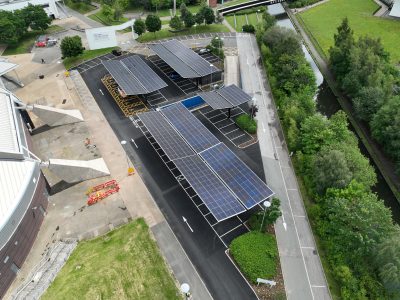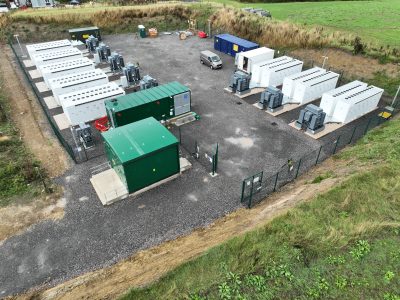British Antarctic Survey
Funded by the National Environment Research Council, the eminent British Antarctic Survey delivers and enables cutting discoveries in the Polar Regions.
SCROLL

K e y S t a t s
CO2 saved 1st year
109,388kg
System size
675kwp
Panel model
Trina TSM 275
Inverter model
Solaredge
Annual Generation
565,667kWh
Solar Used Onsite
92.5%
The Challenge
BAS is an institute funded by the Natural Environment Research Council to deliver cutting edge investigations into the Polar Regions. The owners of the site saw an opportunity to regain some of their electricity costs by placing solar PV arrays over their car parking lot. They decided to invest in solar carports and make the most of their available space to allow them to generate their own source of renewable energy. This is to be used by the organisation to power their building, or provide an electric vehicle charging facility to their staff and visitors.
To achieve this objective, we were appointed to erect a solar carport and cycle shelter at their site in Cambridge. The client was driven by meeting sustainable development goals, creating a more pleasant, safe place to park, expand and secure their cycling facilities and implement EV charging points to encourage staff uptake of electric vehicles.
OUR SOLUTION
We initially designed and installed 4 Y shaped solar carports, and a solar bike shed, generating 219kWp. The new bike shed has doubled the space available for bicycle storage from 100 to 200 by using a two-tier rack system, with a cycle repair stand and space for bicycle trailers. Rather than using a traditional string inverter setup, which only performs as well as the least efficient module, the installation uses SolarEdge optimisers connected to pairs of modules which make the whole system safer and more efficient.
Its heartbeat communication system lets individual panels talk directly to the inverters in pairs, so in the event of one panel breaking or losing efficiency, only two from the whole array will be affected. In the event of a fire or broken cable, the inverters make the whole PV system safer by dropping the array voltage from 850v to 21v.As a result of an optimised system, the inverters are smaller than standard inverters.
Their performance can be accessed in real-time online, individual module monitoring, which allows us to swiftly identify and remedy any issues. Along with the carports and bike shed, a 7 kW twin column mounted PodPoint EV charger was installed. The design process was complex and tailored to suit the site. Overall, both the system and EV charger were fitted over two months.
Due to the success of this project, our team was commissioned to install 456kWp of solar atop another one of their buildings on the site, cumulatively making up a total system size of 675kWp.
THE RESULT
The initial project was finished in May 2019 with the additional roof top solar PV system completed in mid-2022, and has been operating successfully since. In addition to the system, the client also wanted to improve the security levels in the carpark and optimise traffic flow, so entry and exit barriers were installed with an intercom system. Pathways were improved and adjusted to a new layout to improve safety for pedestrians and cyclists.
Careful management of the carpark was required throughout the construction of the site to maintain the usability of parts of the carpark and guarantee safety for all, including contractors public, and users. Useable space was limited, for storage, leading to staged deliveries of steelwork, solar panels and inverters.
The array, stretching over 96 car parking spaces, should cut the site’s carbon footprint by over 109,388kg per year (1st year), contributing towards the BAS environmental objectives, and encouraging alternative travel methods (EV and bike). The carpark was originally planted with shrubs and flowers in beds around car parking spaces. They were removed temporarily to allow construction of the carport, with the intention of reinstating the vegetation after the construction to retain biodiversity.




